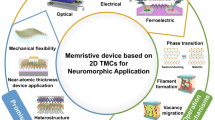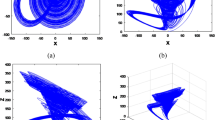Abstract
The physical conception of the memristor by the Hewlett-Packard Labs has opened the possibility of combining this new fundamental circuit element with traditional devices in order to carried out novel applications. An important step for incorporating the memristor into the computer-aided design tools is to find an expression that represents the behavior of the device. In this paper, a novel modeling methodology for memristive systems using homotopy perturbation methods is introduced. This methodology is capable of generating a semi-symbolical expression that represents the memristive behavior of the device. The new memristor model is characterized in order to determinate the impact of the variables on the memristive behavior and establishes the range of compliance using the principal fingerprints of the memristor. Besides, the novel memristor model is depicted by two cases of study. Finally, the advantages of the memristor model are presented and discussed.













Similar content being viewed by others
References
H. Abdalla and M. Pickett. Spice modeling of memristors. In IEEE International Symposium on Circuits and Systems (ISCAS), 2011, pp. 1832–1835 (2011)
S. Adhikari, M. Sah, H. Kim, L. Chua, Three fingerprints of memristor. IEEE Trans. Circuits Syst. I: Regular Papers 60(11), 3008–3021 (2013)
D. Batas, H. Fiedler, A memristor spice implementation and a new approach for magnetic flux-controlled memristor modeling. IEEE Trans. Nanotechnol. 10(2), 250–255 (2011)
R. Berdan, C. Lim, A. Khiat, C. Papavassiliou, T. Prodromakis, A memristor spice model accounting for volatile characteristics of practical reram. IEEE Electron Device Lett. 35(1), 135–137 (2014)
D. Biolek, Z. Biolek, V. Biolkova, Pinched hysteretic loops of ideal memristors, memcapacitors and meminductors must be ’self-crossing’. Electron. Lett. 47(25), 1385–1387 (2011)
D. Biolek, Z. Biolek, V. Biolkova, and Z. Kolka. Some fingerprints of ideal memristors. In IEEE International Symposium on Circuits and Systems (ISCAS), 2013, pp. 201–204 (2013)
Z. Biolek, D. Biolek, V. Biolkova, Spice model of memristor with nonlinear dopant drift. Radioengineering 18, 210–214 (2004)
Z. Biolek, D. Biolek, V. Biolkova, Spice model of memristor with nonlinear dopant drift. Radioengineering 18(2), 210–214 (2009)
R. Burden, J. Faires, Numerical Analysis (Cengage Learning, Boston, MA, 2004)
L. Chua, Memristor-the missing circuit element. IEEE Trans. Circuit Theory 18(5), 507–519 (1971)
L. Chua, S.M. Kang, Memristive devices and systems. Proc. IEEE 64(2), 209–223 (1976)
L. O. Chua, P. Y. Lin. Computer-Aided Analysis of Electronic Circuits: Algorithms and Computational Techniques. Prentice Hall Professional Technical Reference, 1975. ISBN:0131654152
M. Di Ventra, Y. Pershin, L. Chua, Circuit elements with memory: memristors, memcapacitors, and meminductors. Proc. IEEE 97(10), 1717–1724 (2009)
U. Filobello-Nino, Hpm applied to solve nonlinear circuits: a study case. Appl. Math. Sci. 6(87), 4331–4344 (2012)
C. Hernández-Mejía, A. Sarmiento-Reyes, H. Vázquez-Leal. A family of memristive-transfer functions of negative-feedback nullor-based amplifiers. Circuits Syst. Signal Process. 1–17 (2015). ISSN 0278-081X. doi:10.1007/s00034-015-0013-9
H. Ji-Huan, Homotopy perturbation technique. Comput. Methods Appl. Mech. Eng. 178(34), 257–262 (1999)
H. Ji-Huan, A coupling method of a homotopy technique and a perturbation technique for non-linear problems. Int. J. Non-Linear Mech. 35(1), 37–43 (2000)
Y.N. Joglekar, S.J. Wolf, The elusive memristor: properties of basic electrical circuits. Eur. J. Phys. 30, 661–675 (2009)
H. Kim, M.P. Sah, S.P. Adhikari. Pinched hysteresis loops is the fingerprint of memristive devices. Mesoscale and Nanoscale Physics (2012). arXiv:1202.2437
M. Mahvash and A. Parker. A memristor spice model for designing memristor circuits. In IEEE International Midwest Symposium on Circuits and Systems (MWSCAS), 2010 53rd, pp. 989–992 (2010)
Y. V. Pershin, M. Di Ventra. SPICE model of memristive devices with threshold. ArXiv e-prints (2012)
Y.V. Pershin, S. La Fontaine, M. di Ventra, Memristive model of amoeba learning. Phys. Rev. E 80(2), 021926 (2009)
T. Prodromakis, B.P. Peh, C. Papavassiliou, C. Toumazou, A versatile memristor model with nonlinear dopant kinetics. IEEE Trans. Electron Devices 58(9), 3099–3105 (2011)
A. Rak, G. Cserey, Macromodeling of the memristor in spice. IEEE Trans. Comput. Aided Design Integr. Circuits Syst. 29(4), 632–636 (2010)
S. Shin, L. Zheng, G. Weickhardt, S. Cho, S.-M. Kang, Compact circuit model and hardware emulation for floating memristor devices. IEEE Circuit. Syst. Mag. 13(2), 42–55 (2013)
D.B. Strukov, G.S. Snider, D.R. Stewart, R.S. Williams, The missing memristor found. Nature 453(7191), 80–83 (2008)
J.J. Yang, M.D. Pickett, X. Li, D.A.A. Ohlberg, R.S. Williams, D.R. Stewart, Memristive switching mechanism for metal/oxide/metal nanodevices. Nature 3(7), 429–433 (2008)
Author information
Authors and Affiliations
Corresponding author
Rights and permissions
About this article
Cite this article
Hernández-Mejía, C., Sarmiento-Reyes, A. & Vázquez-Leal, H. A Novel Modeling Methodology for Memristive Systems Using Homotopy Perturbation Methods. Circuits Syst Signal Process 36, 947–968 (2017). https://doi.org/10.1007/s00034-016-0346-z
Received:
Revised:
Accepted:
Published:
Issue Date:
DOI: https://doi.org/10.1007/s00034-016-0346-z




